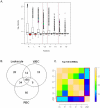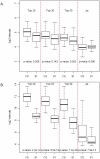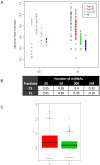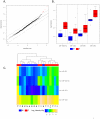Impact of cellular miRNAs on circulating miRNA biomarker signatures
- PMID: 21698099
- PMCID: PMC3117799
- DOI: 10.1371/journal.pone.0020769
Impact of cellular miRNAs on circulating miRNA biomarker signatures
Abstract
Effective diagnosis and surveillance of complex multi-factorial disorders such as cancer can be improved by screening of easily accessible biomarkers. Highly stable cell free Circulating Nucleic Acids (CNA) present as both RNA and DNA species have been discovered in the blood and plasma of humans. Correlations between tumor-associated genomic/epigenetic/transcriptional changes and alterations in CNA levels are strong predictors of the utility of this biomarker class as promising clinical indicators. Towards this goal microRNAs (miRNAs) representing a class of naturally occurring small non-coding RNAs of 19-25 nt in length have emerged as an important set of markers that can associate their specific expression profiles with cancer development. In this study we investigate some of the pre-analytic considerations for isolating plasma fractions for the study of miRNA biomarkers. We find that measurement of circulating miRNA levels are frequently confounded by varying levels of cellular miRNAs of different hematopoietic origins. In order to assess the relative proportions of this cell-derived class, we have fractionated whole blood into plasma and its ensuing sub-fractions. Cellular miRNA signatures in cohorts of normal individuals are catalogued and the abundance and gender specific expression of bona fide circulating markers explored after calibrating the signal for this interfering class. A map of differentially expressed profiles is presented and the intrinsic variability of circulating miRNA species investigated in subsets of healthy males and females.
Conflict of interest statement
Figures







References
Publication types
MeSH terms
Substances
LinkOut - more resources
Full Text Sources
Other Literature Sources
Molecular Biology Databases
Research Materials
Miscellaneous

